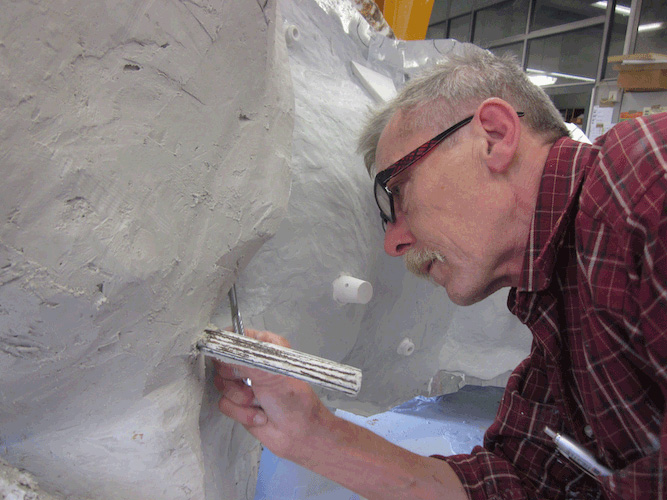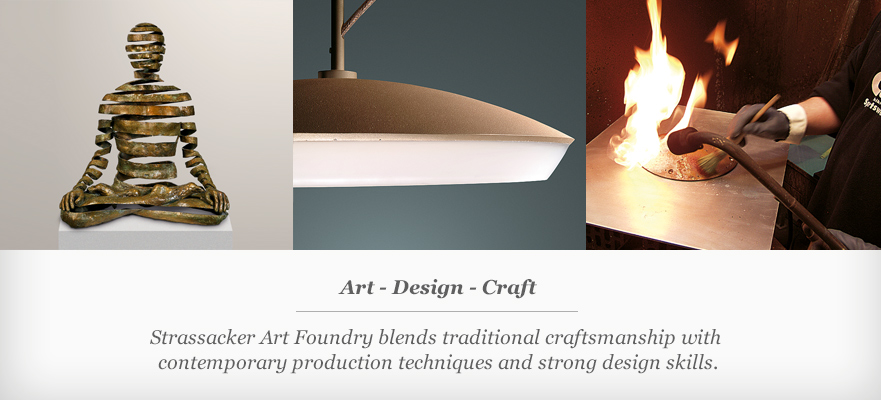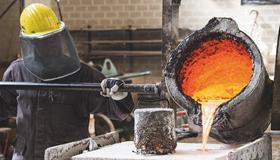Producing bronze art
From model to final artwork
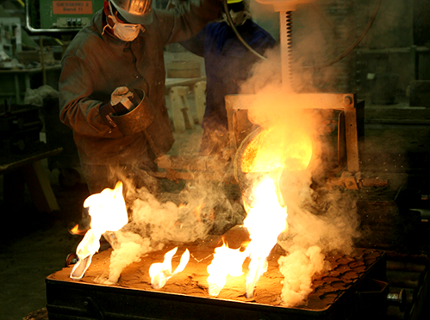
Producing bronze art
The possibilities when producing bronze art are practically endless. From miniatures to massive monuments, from archaic or delicately chased to highly polished surfaces: there is such variety in objects cast in metal and precious metal. Learn more about the complex production process for bronze art.
Ernst Strassacker GmbH & Co. KG uses the following materials and alloys:
- Bronze: Rg5 / G-CuSn5ZnPb (gunmetal/red brass), GBz 10 / G-CuSn10 (tin bronze)
- Aluminum: Al239 / G-AlSi9Mg
- Brass, nickel silver and stainless steel
Further informationFind out what else Strassacker can offer artists
Building models and molds
A model is the creative precursor to an art cast. It is based on an idea that is sketched either by the artist or by Strassacker draftsmen. This outline of an idea is then translated to a three-dimensional model. This model is used as the basis for the actual cast. Strassacker employs its own sculptors and designers to create models, all of whom have a vast spectrum of experience in graphic model design. Before casting, the final model is shown to the client for approval.
Model-making materials:
wood, styrofoam, plaster, plastic, plasticine, modeling wax, etc.
Casting
There are several options for producing bronze art. Sculptures can be cast using different techniques depending on their size and shape. It can take up to 20 different steps to create a finished product from the original model. Strassacker advises each artist on the most appropriate casting method based on their model:
Lost wax technique
This technique is one of the oldest, but by no means the simplest, casting method and has been gradually perfected over millennia. All methods start with a hollow wax model made from a flexible molding material.
There are three different techniques that fall under the heading of Lost wax technique:
-
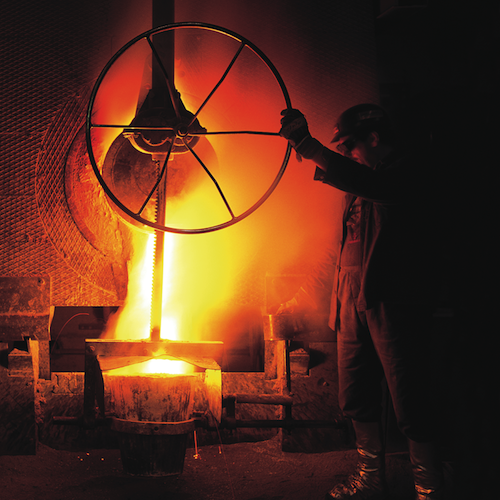
The bronze is heated to around 1250° C in a kiln before being poured into the mold.
Plaster mold casting
-
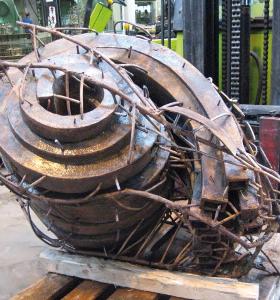
For a block mold cast, the fireclay mold spends several days burning away in an oven.
Block mold casting with a plaster/fireclay mix
Here the hollow wax model is covered with a mix of plaster and fireclay. The resulting fireclay mold is placed in an oven at 750 °C and is burnt out over three to four days. Liquid bronze is then poured into the burned out mold in a single motion. Once the model hardens, the fireclay cast is broken up to reveal the artwork.
- Can be used for an object with regular specifications
- Clay form is burnt out at 750°C for three to four days.
- Bronze is cast at 1250°C into the fireclay mold
- Fireclay block is broken up once cooled.
Ceramic mold casting
-
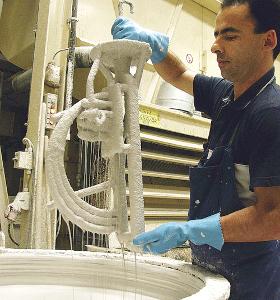
In ceramic mold casting, the wax model is dipped into a ceramic substance four to six times.
Precision casting with the ceramic shell mold process
Ceramic mold casting is used when the object to cast will be subject to special requirements. The mold here is made of a ceramic material. Depending on its size, the wax model is dipped into a ceramic substance four to six times and is then cured. This produces a ceramic shell with a thickness of between 6 and 10 mm. The shell is fully cured in an autoclave and then fired in a furnace at 800°C. The ceramic shell solidifies quickly, after which it is broken up to reveal the cast artwork.
- Can be used for an object with special requirements
- Ceramic shell with 6 - 10 mm thickness fired at 800°C.
- Bronze is cast at 1250°C into the ceramic shell
- Ceramic shell is broken up once cooled.
Vacuum casting
-
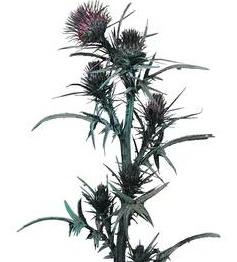
Delicate artworks can be realized using the vacuum flask casting technique.
Ceramic method with vacuum
Vacuum flask casting is the preferred option for complex models. The wax model is placed inside a stainless steel cylinder and then covered with a plaster-bonded molding material, which mixes together and coalesces under vacuum. Once the mass has amalgamated, the model is placed into a furnace and burnt out for several hours. The warm mold is placed into a casting container in a vacuum, and the liquid metal is added. The metal flows accurately into every nook and cranny of the hollow space. Once cool, the cast is carefully flushed out of the stainless steel cylinder.
- Can be used for delicate objects, maximum 50 cm in size
- Hot metal flows into the mold with the help of a vacuum.
- Process takes more time to produce the final cast
- Once cool, the final cast is flushed out of the mold rather than being broken up.
Sand casting
Sand casting is a tried-and-tested technique for reliefs, plaques, crests and small sculptures with few indentations. This process requires a particular consistency of molding sand. Because the grains of sand are so fine, every single detail of the model can be accurately replicated in quartz sand, bonding clay and water.
The sand casting process:
- Where necessary, the art former disassembles the model made of plasticine, wax, plaster or wood to fit the mold.
- The art former uses sand to shape these parts inside the molding box and then removes the model.
- The next step is to carve feeds, sprues and vent channels into the sand mold.
- The mold boxes are pressed firmly against each other and bronze is poured into the resulting hollow space.
- The mold is broken up once the bronze has solidified.
-
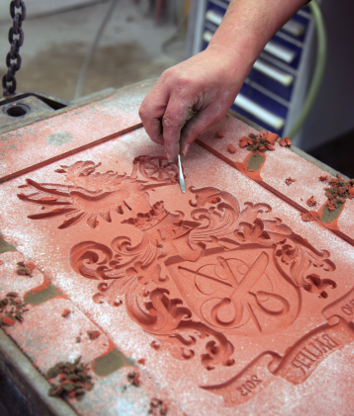
Sand casting is used for reliefs and plaques.
Chasing and adding patinas
Dazzling surfaces
Many artworks are treated by a chaser after casting. Some artists make personal choices as to how the sculpture should be brought to life through treating the surface.
The chaser works on the surfaces using a chisel or gouge along with files, planes and tools for sanding and polishing. With intense concentration, faces, muscles and ornamentation emerge piece by small piece, highlighting nuances and emphasizing the object’s unique features.
-
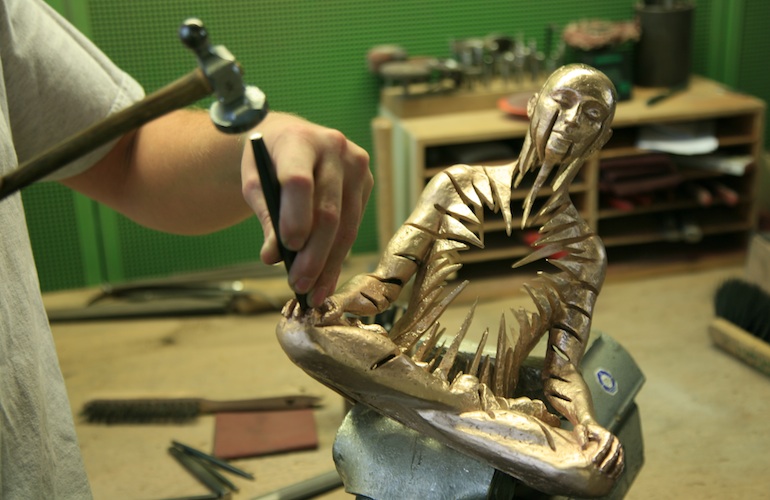
A chaser uses hammers, hallmarks and chisels to treat the surface of a bronze sculpture.
-
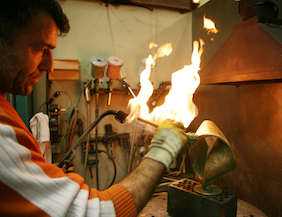
Specialists use chemicals, water and fire to create the unique patina.
Dynamic patina
Adding a patina is the last step in producing bronze art. The patina specialist simply accelerates the natural oxidation process. Bronze changes over time depending on the factors to which the copper alloy is subjected. We work directly with the artist to accurately identify and realize their ideas in terms of color nuances in the patina.
